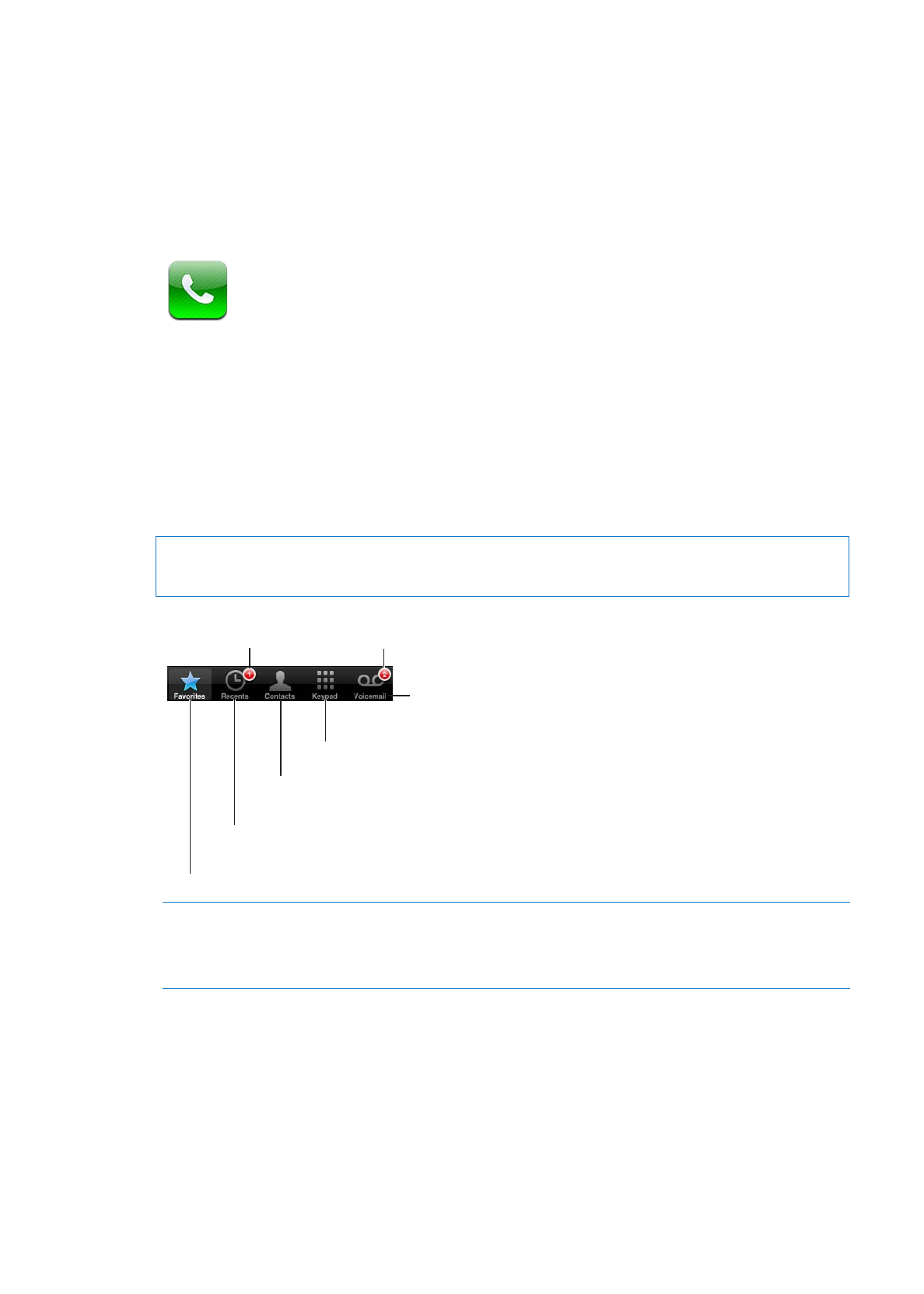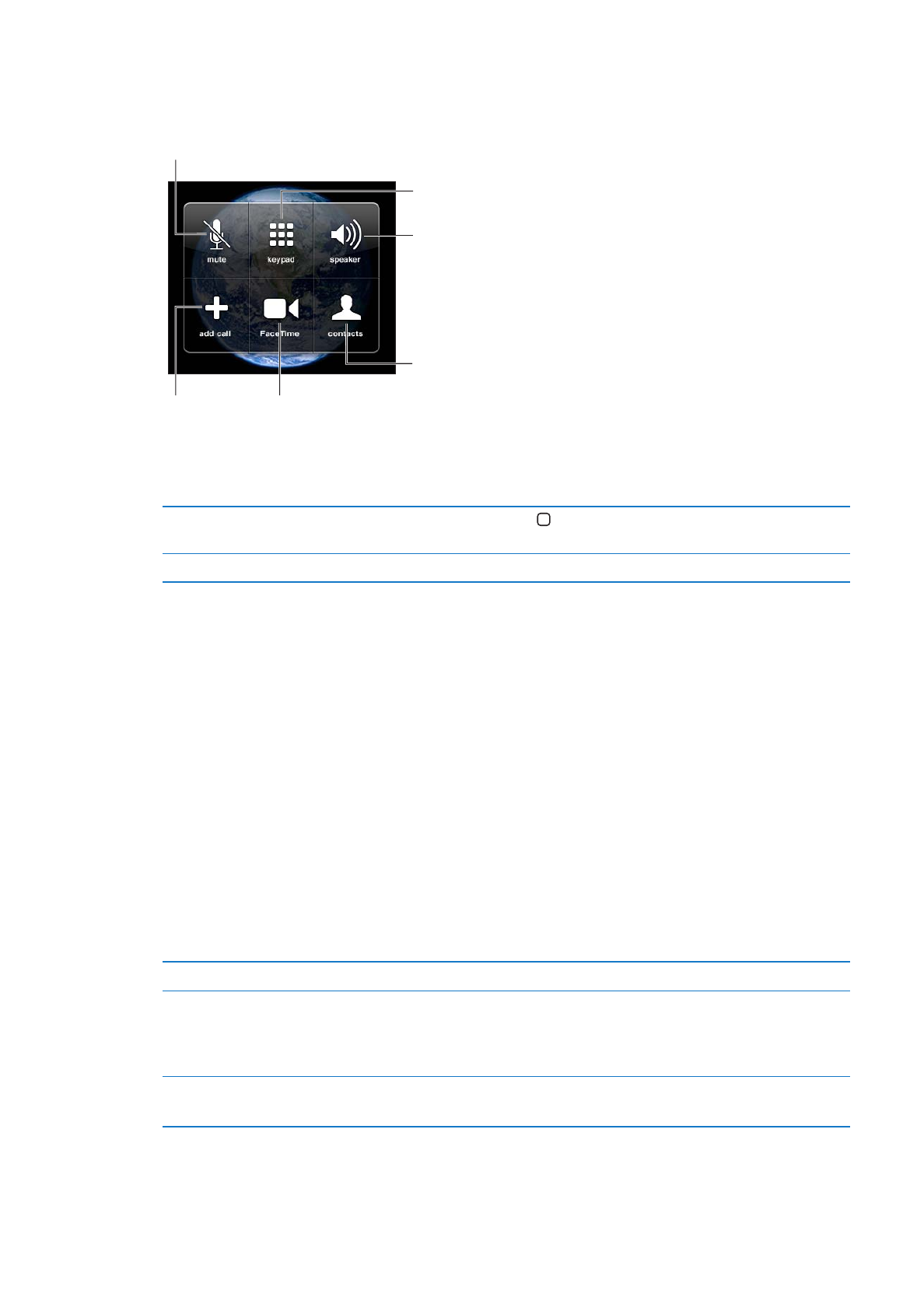
Phone calls
Making a call
Making a call on iPhone is as simple as tapping a name or number in your contacts, using Siri
to say “call bob” (iPhone 4S), tapping one of your favorites, or tapping a recent call to return it.
Buttons at the bottom of the Phone screen give you quick access to your favorites, recent calls,
your contacts, and a numeric keypad for dialing manually.
WARNING:
For important information about driving safely, see the Important Product Information
Guide at www.apple.com/support/manuals/iphone.
Number of
missed calls
Call a favorite with a single tap.
View your recent incoming and outgoing
calls to return a call or get more info.
Call, email, or text someone
in your contacts list.
Dial manually.
View a list of
your voicemail
messages.
Number of
unheard messages
Return a missed call
Do one of the following:
Â
Phone: Tap Recents, then tap the name or number.
Â
Locked screen: Swipe the icon displayed in the alert to the right.
Â
Notification Center: Tap the missed call.
56

Dialing manually
You can use the keypad to dial a phone number manually.
Dial a number: Tap Keypad, enter the number, then tap Call.
Paste a number to the keypad
Tap the screen above the keyboard, then tap Paste.
Enter a soft (2-second) pause
Touch the “*” key until a comma appears.
Enter a hard pause (to pause
dialing until you tap the
Dial button)
Touch the “#” key until a semicolon appears.
Redial the last number
Tap Keypad, tap Call, then tap Call again.
Voice dialing
You can use Siri (iPhone 4S) or Voice Control to call someone in your contacts, or to dial a specific
number. See Chapter 4, “Siri,” on page 39 and “Voice Control” on page 30.
Make a phone call by voice: Activate Siri or Voice Control, say “call” or “dial,” then say the name
or number.
Siri: If the screen isn’t on, press the On/Off or Home button , then hold iPhone to your ear.
Voice Control or Siri: Press and hold the Home button until you hear the tone. You can also
press and hold the center button on the iPhone earphones.
For example:
Call John Appleseed
Â
Call John Appleseed at home
Â
Call John Appleseed, mobile
Â
For best results, speak the full name of the person you’re calling. When voice dialing a number,
speak each digit separately—for example, say “four one five, five five five, one two one two.”
Note: For the “800” area code in the U.S., you can say “eight hundred.”
Receiving calls
When you receive a call, tap Answer. If iPhone is locked, drag the slider. You can also press the
center button on your iPhone earphones.
Silence a call
Press the On/Off button or either volume button. You can still answer the
call after silencing it, until it goes to voicemail.
Decline a call and send it directly
to voicemail
Do one of the following:
Â
Press the On/Off button twice quickly.
Â
Press and hold the center button on the iPhone earphones for about two
seconds. Two low beeps confirm that the call was declined.
Â
Tap Decline (if iPhone is awake when a call comes in).
Block calls and maintain Wi-Fi
access to the Internet
Go to Settings and turn on Airplane Mode, then tap Wi-Fi to turn it on.
If iPhone is turned off or in Airplane Mode, incoming calls go directly to voicemail.
57
Chapter 5
Phone

While on a call
When you’re on a call, the screen shows call options.
Mute your line.
iPhone 4 or later: Touch and
hold to put your call on hold.
Dial a number or
enter numbers.
Use the
speakerphone
or a Bluetooth
device.
Get contact info.
iPhone 4 or later:
Make a FaceTime call.
iPhone 3GS (Hold button):
Put a call on hold.
Make another
call.
The call options may vary, depending on which iPhone you’re using.
Use another app during a call
Press the Home button , then tap an app icon. To return to the call, tap
the green bar at the top of the screen.
End a call
Tap End Call. Or press the center button on your iPhone earphones.
Second calls
During a call, you can make or receive another call. If you receive a second call, iPhone beeps and
shows the caller’s information and a list of options.
Note: Making and receiving a second call may be an optional service in some areas. Contact your
carrier for more information.
Respond to a second incoming call:
Â
To ignore the call and send it to voicemail: Tap Ignore.
Â
To hold the first call and answer the new one: Tap Hold Call + Answer.
Â
To end the first call and answer the new one: When using a GSM network, tap End Call + Answer.
With a CDMA network, tap End Call and when the second call rings back, tap Answer, or drag
the slider if the phone is locked.
If you’re on a FaceTime video call, you can either end the video call and answer the incoming call,
or decline the incoming call.
Make a second call
Tap Add Call. The first call is put on hold.
Switch between calls
Tap Swap. The active call is put on hold.
With CDMA, you can’t switch between calls if the second call was outgoing,
but you can merge the calls. If you end the second call or the merged call,
both calls are terminated.
Merge calls
Tap Merge Calls.
With CDMA, you can’t merge calls if the second call was incoming.
58
Chapter 5
Phone

Conference calls
With GSM, you can set up a conference call to talk with up to five people at a time, depending on
your carrier.
Note: Conference calling may be an optional service in some areas. Contact your carrier for
information.
Create a conference call:
1
Make a call.
2
Tap Add Call and make another call. The first call is put on hold.
3
Tap Merge Calls. The calls are merged on one line and everyone can hear each other.
4
Repeat steps two and three to add additional calls.
Drop one call
Tap Conference and tap
next to a call. Then tap End Call.
Talk privately with a call
Tap Conference, then tap Private next to a call. Tap Merge Calls to resume
the conference call.
Add an incoming call
Tap Hold Call + Answer, then tap Merge Calls.
If your service includes conference calling, iPhone always has a second line available in addition to
the conference call.
Note: You can’t make a FaceTime video call when you’re on a conference call.
Using a Bluetooth device for calls
You can make and receive calls using a Bluetooth device paired with iPhone. See “Pairing a
Bluetooth device with iPhone” on page 34.
For information about using a Bluetooth device, see the documentation that came with the device.
Bypass your Bluetooth device:
Answer a call by tapping the iPhone screen.
Â
During a call, tap Audio and choose iPhone or Speaker Phone.
Â
Turn off Bluetooth in Settings > General > Bluetooth.
Â
Turn off the Bluetooth device, or move out of range. You must be within about 30 feet of a
Â
Bluetooth device for it to be connected to iPhone.
Emergency calls
If iPhone is locked with a passcode, you may still be able to make an emergency call.
Make an emergency call when iPhone is locked: On the Enter Passcode screen, tap Emergency
Call, then enter the emergency number and tap the green button.
In the U.S., location information (if available) is provided to emergency service providers when
you dial 911.
With CDMA, when an emergency call ends, iPhone enters Emergency call mode to allow a call back
from emergency services. While in this mode, data transmission and text messages are blocked.
Exit emergency call mode (CDMA): Do one of the following:
Tap the back button.
Â
Press the On/Off button or the Home button
Â
.
Use the keypad to dial a non-emergency number.
Â
Emergency call mode ends automatically after a few minutes, as determined by your carrier.
59
Chapter 5
Phone

Important:
You should not rely on wireless devices for essential communications, such as medical
emergencies. Use of iPhone to call emergency services may not work in all areas or all operating
conditions. Emergency numbers and services vary by area, and sometimes an emergency call
cannot be placed due to network availability or environmental interference. Some cellular
networks may not accept an emergency call from iPhone if iPhone is not activated, if iPhone is not
compatible with or configured to operate on a particular cellular network, or (when applicable) if
iPhone does not have a SIM or if the SIM is PIN-locked. If you’re on a FaceTime video call, you must
end that call before you can call an emergency number.
FaceTime
FaceTime video calls (iPhone 4 or later) let you see as well as hear the person you’re talking to. You
can make a video call to someone with a Mac or iOS device that supports FaceTime. No setup is
needed, but you must have a Wi-Fi connection to the Internet. By default, FaceTime uses the front
camera so the person you call can see your face; switch to the rear camera to share what you see
around you.